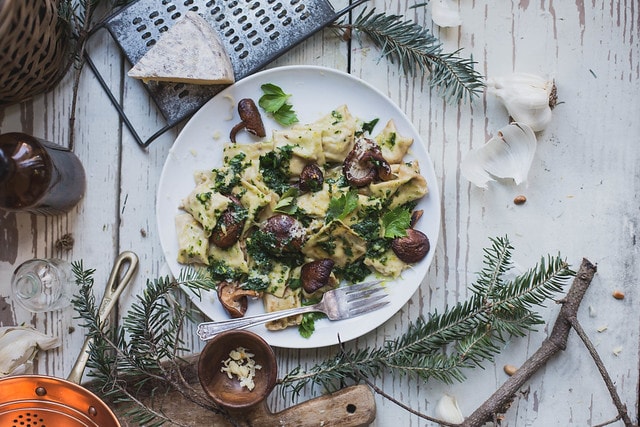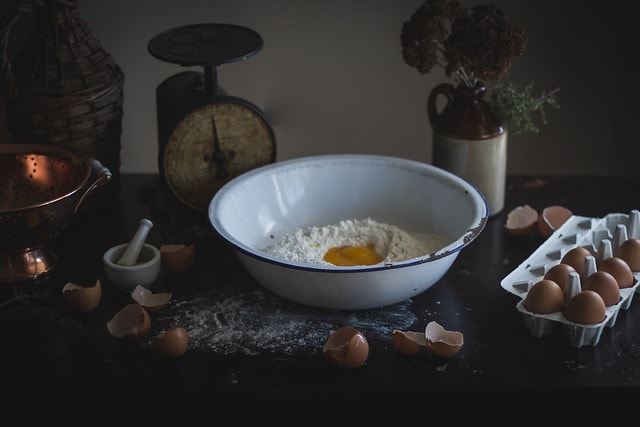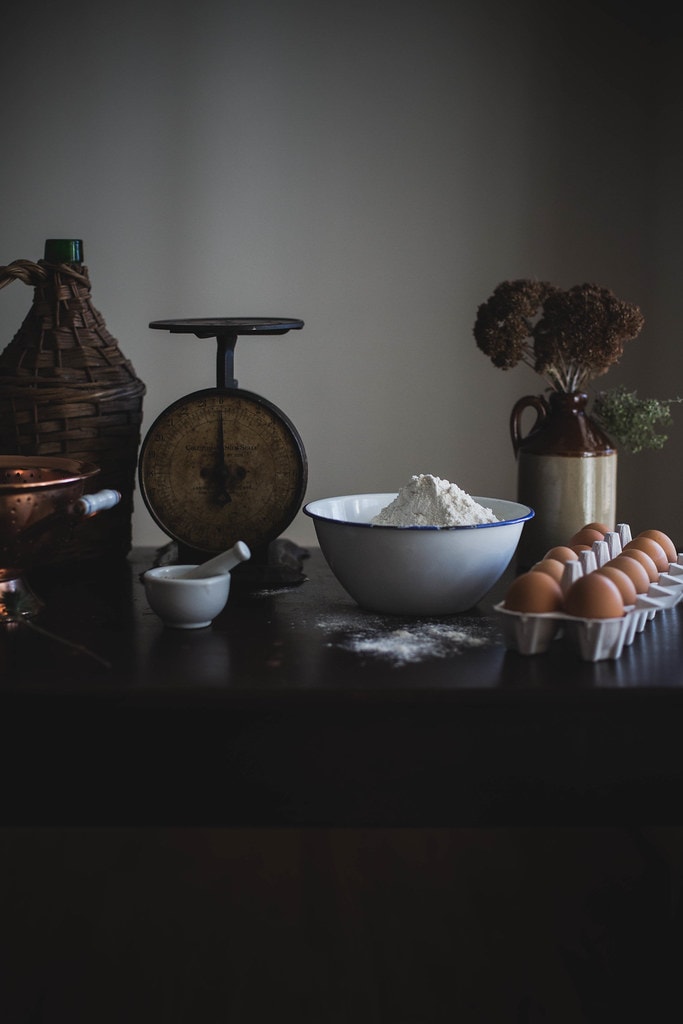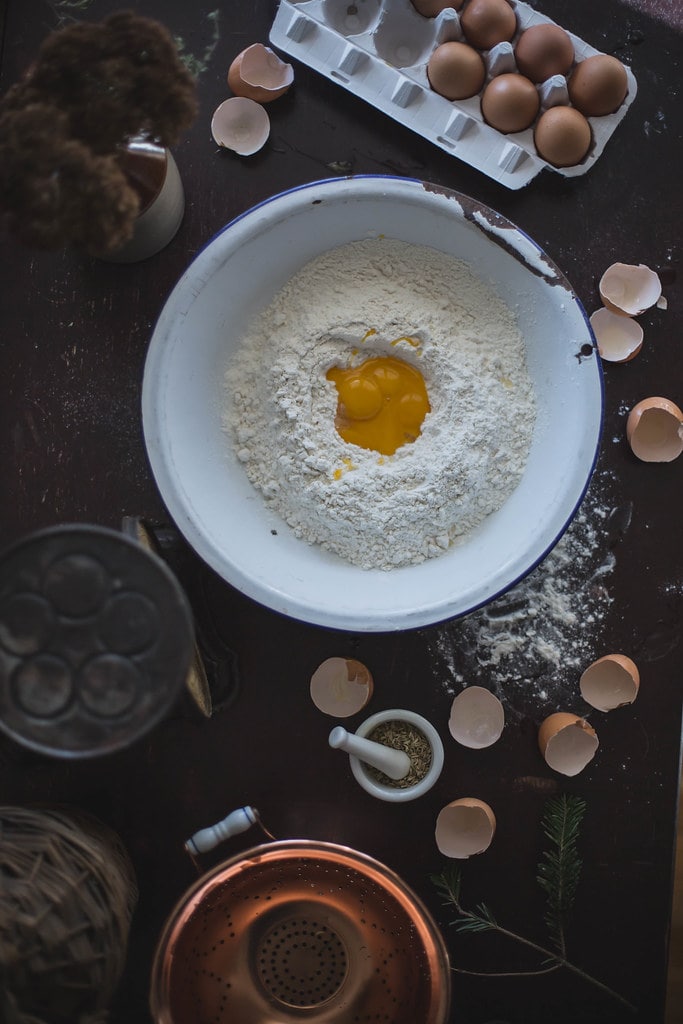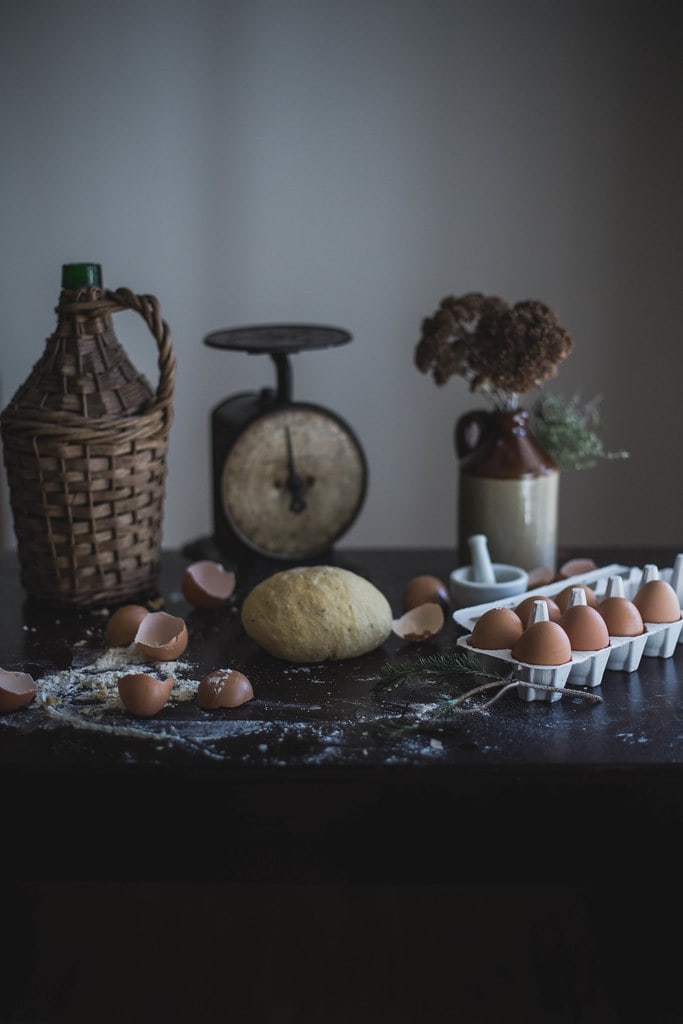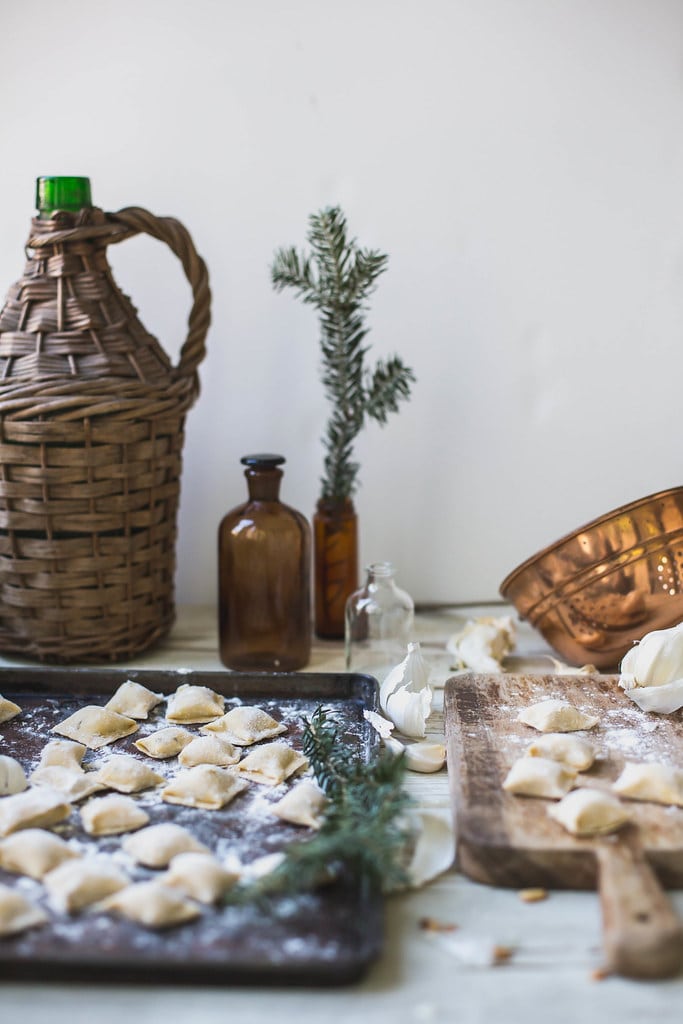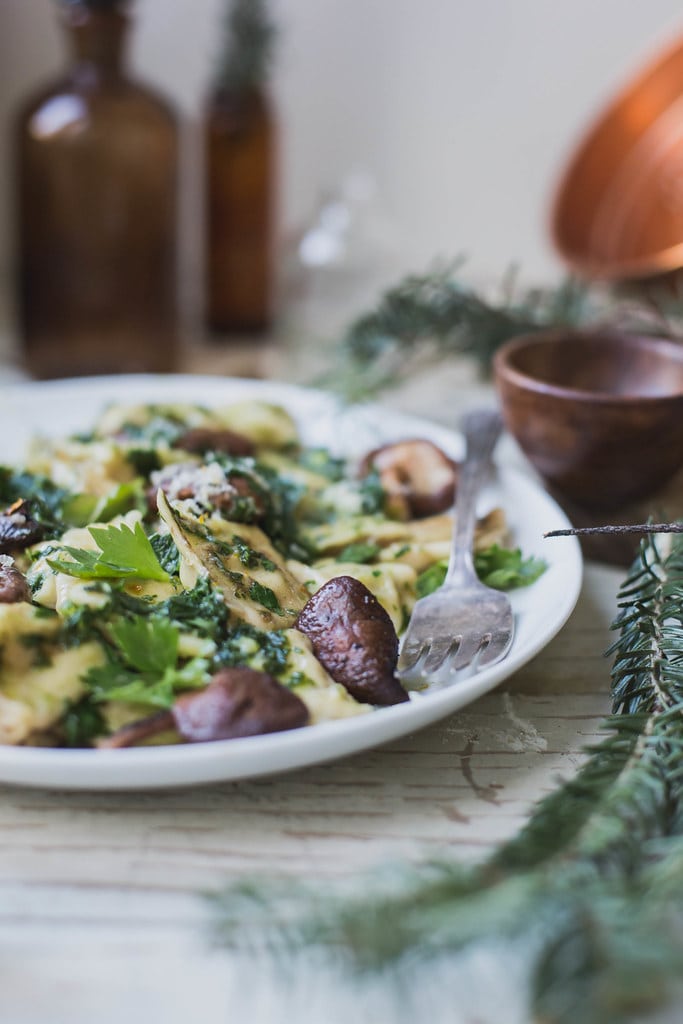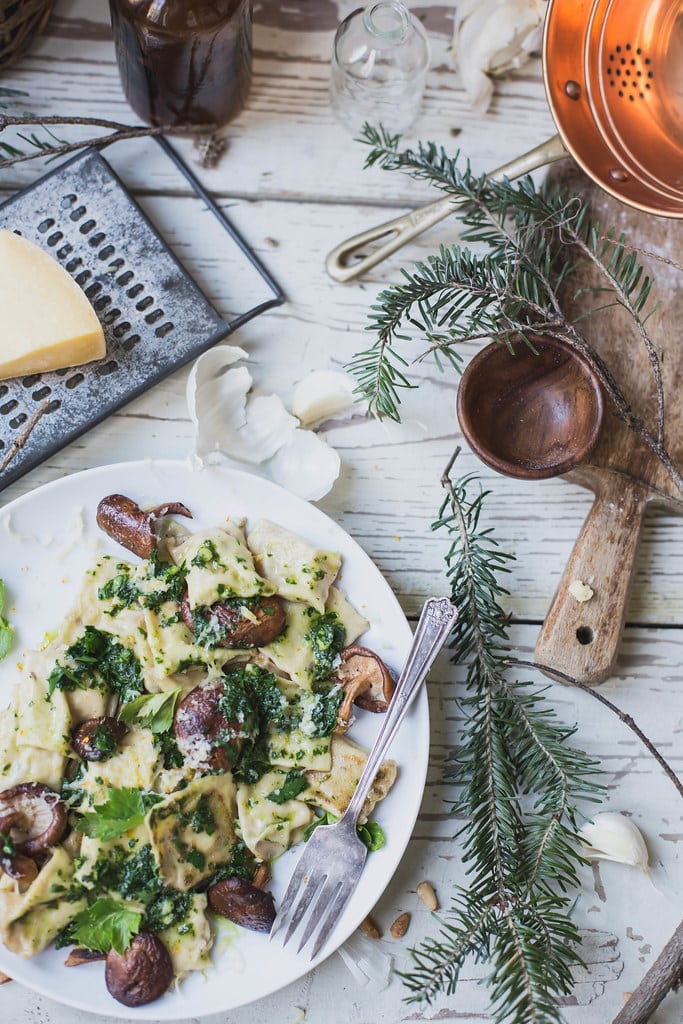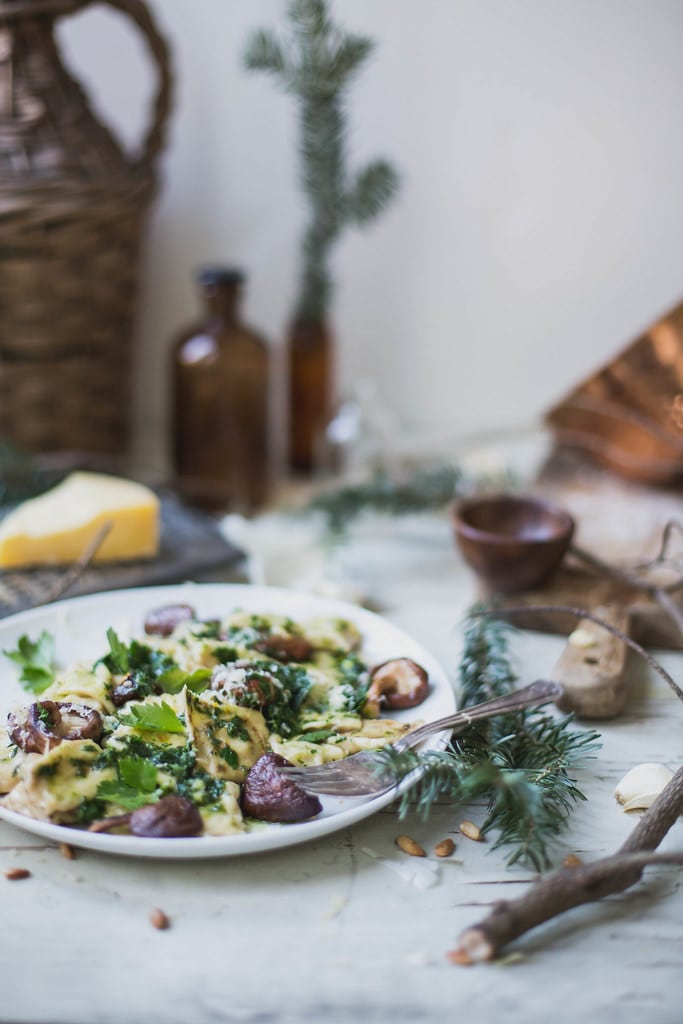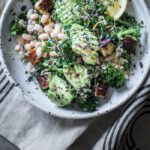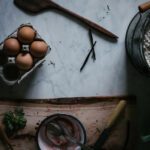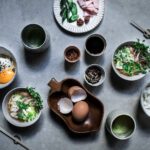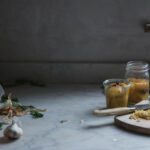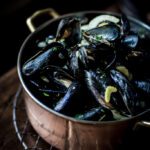If there is any food that typifies the mundane made special, it’s fresh, handmade pasta. It’s plain, whole food: soft grain & fresh eggs. Little more. Making it isn’t glamorous. It’s manual labor, messy hands and spatters of flour, kneading down through your forearms. Simple kitchen work, good & grounding. For years I found making fresh pasta daunting. For reasons unknown to me it seemed mercurial, untrustworthy. Like a raised eyebrow might send my pasta into a fit causing it to fail. Blessedly, these were all lies. It’s easy. It’s something your hands will just know. Forget the box. Flour & the loyal egg are all you need to create a silky canvas for whatever seasonal produce comes your way. Today, we have fresh pasta with a bit of ground fennel seed in it serving as the medium for a creamy celery root & Noble Spring’s herb de provence crusted goat cheese filling; shiitakes; and a bright yet earthy brown butter, Meyer lemon, and parlsey pesto. Every now and again, every so rarely (I’m one of those “own worst critic” sorts but aren’t we all) I create something I want to pat myself on the back for. This is one of those times. It’s a little stupid how good & comforting these agnolotti are, how refined a gnarled celery root can taste. Meditative to make and warming to eat, it’s the perfect dish for this time of year when stress runs high and worlds collide.
The holidays, once a season that couldn’t come fast enough, now seems to stampede in like a bedazzled herd of elephants. I’m a Christmas lover. I always have been. I love the cold and the small lights in the great dark. The reverence mixed with bawdy festivity and all of it tied up in brown paper packages beneath fir trees in twine.
This morning December was finally real; there was frost. It made me feel stark raving mad. It made want it to always be cold, to be cold forever. Everything felt so clear. I was having a flashback to some great time in my life when it was very cold, but to when, I don’t know. To a mid-winter week spent feeling like an adult at my friend’s house in high school, listening to Nine Inch Nails and smoking cigarettes on the way to school. When things like that were enough to make me feel alive. I wasn’t even a Nine Inch Nails fan. But that didn’t matter. To a snow covered early Spring in the Netherlands, in love with a Dutchman, tip toeing in the freezing mornings to the shower. Or maybe I was remembering a few painfully hopeful weeks in Portland, walking in the snow & star crossed in love. Or skiing in Beaver Creek with a stranger turned confidant, an unlikely friend that got me through another lousy year in my mid-twenties, the year the Saints won the Superbowl. As I drove this morning, I remembered everyone I never saw again, a life of last good byes, and I wanted to hold everyone I’d ever loved and make them promise to care forever. I wanted every point in time to exist one on top of the other, all at once. I wanted to hoard time. Somehow the shards of frost turning the grass mint green & the brilliant steam induced a roiling, aching energy. I felt okay, like I could be the woman I want to be, someday. I liked the wild eyed frost.
So I had a cup of coffee with my parents. I cried a little. I sang decidedly poorly, alone. And I ground fennel seed, the scent of anise rising out of the mortar. In a great enamel bowl I swirled farm eggs into a mound of flour. I turned out the shaggy mess and went to kneading. I pushed and pushed and pushed. It seemed like it might not get there—everything always seems that way. And then it did. The clouds broke, and I had velvety pasta dough flecked with ground fennel seeds. All that was left was a rest, a roll, and concocting this filling which I dreamt up like a potion, grating the zest of an orange into it on a whim. At the end of the day, I sat on the couch with a plate in my lap and ate, allowing myself to be vacant save the taste and texture. Allowing myself to do nothing but nourish my body with wintery roots, fresh eggs, and grain. If you want more information on the nutritional benefits of grains (yes, pasta has nutritional benefits) & how they go about fortifying your brain visit the Grains Food Foundation. Lord knows my brain chemistry could use the help! And we probably all could this time of year, whether it’s a happy whirlwind or a little blue. Or a lovely mélange.
Because making pasta is a tactile/visual thing, here’s a good tutorial on agnolotti in case reading the instructions proves confusing.
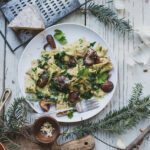
Ingredients
For Pasta:
- 1 tablespoon of freshly ground fennel seed
- 4 eggs 2 parts by weight
- 3 parts flour by weight
- OR if you don’t have a scale
- 2 cups all purpose flour
- 4 eggs
For Filling:
- 1 pint heavy cream
- 2 celery roots peeled and 1/2″ cubed
- 4 cloves garlic lightly crushed and sliced
- 1 teaspoon kosher salt or to taste
- 1 teaspoon dried herbs de Provence omit if using herbed goat cheese
- zest of 1 large orange or two small
- 1/2 cup pine nuts toasted & chopped
- 1/4 cup + 2 tablespoons of goat cheese I use Noble Spring’s herb de Provence chevre
- For Brown Butter Parsley Pesto
- 2 cups flat leaf parsley
- 4 Tbsp butter browned
- 1 Tablespoon olive oil
- 1/4 cup pine nuts toasted & chopped
- juice of half a Meyer lemon or more to taste
- kosher salt to taste
- For Mushrooms:
- 3/4 lb shiitakes sliced if large and stemmed
- 2 Tbsp unsalted butter + 1 tablespoon to finish
- salt to taste
Instructions
- Make pasta. Place the flour and fennel seed in a large bowl or simply on a work surface and mix to combine. Create a well in the middle (I prefer the less messy bowl).
- Crack the eggs into the well, and using your finger, swirl the eggs incorporating the flour little by little from the sides of the well. Once you start to have what looks like a dough turn it out onto a work surface and start kneading away. Don’t be afraid if it’s crumbly or shaggy. Just keep kneading. Though, if it’s so dry it seems difficult to incorporate all your flour, just don’t incorporated it. You can always knead in more flour later in the game. Knead for 5-10 minutes, flouring only as needed to keep from sticking, until you have a velvety, smooth dough. If you dough seems very dry, wet your hands and knead a bit more. You want a smooth, supple dough that is neither dry nor wet.
- Press your finger into the dough. The imprint should bounce back. Once the imprint bounces back and the dough is smooth, wrap tightly in plastic wrap and allow to rest for about an hour. Meanwhile…
- Make the filling. Bring the cream along with the salt, herbs de Provence, and orange zest to a boil over med-hi heat, stirring frequently to keep from scorching on the bottom. When boiling, add the celery root and garlic, reduce to a vigorous simmer, and cook until the celery root is very tender, about ten minutes. Stir frequently to prevent scorching or skimming.
- Once celery root gives no resistance when pierced, strain, keeping about 1 Tbsp of cream in it. Reserve cream for another use (makes an excellent pasta sauce or sauce on chicken or fish!).
- Mix strained celery root with goat cheese and chopped pine nuts. Puree until smooth. Refrigerate to cool completely.
- Make Pesto. In a mini-food processor or blender combine all ingredients and pulse to combine. Don’t completely puree—you want it to have some texture but no big leaves or chunks. Adjust seasoning to taste.
- Roll pasta & assemble agnolotti. Spoon your filling into a plastic piping bag or a ziplock with a hole cut in the corner. Set aside.
- Pinch off a piece of your pasta dough about the size of a tennis ball, remembering to rewrap the rest. It dries out quickly. Pinch and knead this piece in your hand a bit and then roll it through your pasta roller according to the manufacturer’s instructions, rolling it through the widest setting a few times, folding the dough in half and passing it back through each time, about 3-4 times, before proceeding to the higher settings. The dough should come through smooth before proceeding. Continue to fold and pass the dough through the widest setting until it is smooth (not tearing or anything like that).
- If your pasta sheet gets too long as it gets thinner, cut it in half, dust the half you aren’t using with flour and cover with a damp paper towel. Once the sheet has been passed through the highest setting it should be so thin you can see your hand through it.
- Lay the sheet on a floured work surface, it should be about 12″ long and about 4″ wide. Pipe the filling in one continuous line, about 1/2″ wide, down the sheet, leaving one inch on one side of the piped filling and about two on the other.
- Dip your finger in cold water and wet the sheet of pasta about 1″ away from the filling in a long line that runs the length of the filling on the side with 2″ inches of pasta to spare. Roll the whole thing into a tube. Gently press along the tube in about 3/4″ intervals to form pockets of filling. Cut between pockets and set on a floured sheet tray. Repeat with remaining pasta and filling.
- Bring a large, salted pot of water to a boil. Meanwhile melt the butter in a large skillet and sauté the mushrooms until brown and they’ve released their liquid. Set aside on a plate. Melt one more tablespoon of butter in the skillet and leave it on medium-high for the agnolotti as they come out of the pot.
- Boil agnolotti until they float, about 1 minute. Transfer with a slotted spoon to the skillet with butter, shaking vigorously to prevent sticking. Add in the pesto and mushrooms. Toss to coat and heat.
- Serve garnished with grated hard cheese (maybe something local?) and celery leaves.
Notes
Disclaimer: This is a sponsored post, and I was compensated for my participation. The opinions, stories, recipes, and ramblings are, naturally, all my own.
My name is Beth, Elizabeth Evelyn to be exact. A native Tennessean, I was born in the South.
I am the author behind Local Milk Blog.

